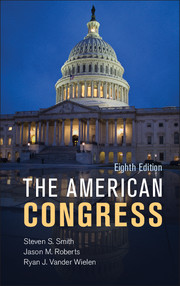Book contents
- Frontmatter
- Contents
- PREFACE
- Acknowledgments
- 1 The Troubled Congress
- 2 Representation and Lawmaking in Congress
- 3 Congressional Elections and Policy Alignments
- 4 Members, Goals, Resources, and Strategies
- 5 Parties and Leaders
- 6 The Standing Committees
- 7 The Rules of the Legislative Game
- 8 The Floor and Voting
- 9 Congress and the President
- 10 Congress and the Courts
- 11 Congress, Lobbyists, and Interest Groups
- 12 Congress and Budget Politics
- Appendix Introduction to the Spatial Theory of Legislating
- Index
- References
10 - Congress and the Courts
- Frontmatter
- Contents
- PREFACE
- Acknowledgments
- 1 The Troubled Congress
- 2 Representation and Lawmaking in Congress
- 3 Congressional Elections and Policy Alignments
- 4 Members, Goals, Resources, and Strategies
- 5 Parties and Leaders
- 6 The Standing Committees
- 7 The Rules of the Legislative Game
- 8 The Floor and Voting
- 9 Congress and the President
- 10 Congress and the Courts
- 11 Congress, Lobbyists, and Interest Groups
- 12 Congress and Budget Politics
- Appendix Introduction to the Spatial Theory of Legislating
- Index
- References
Summary
The battle over judicial nominees has raged in the past two decades at least in part because the House, Senate, and president are not the only institutional players in the policy-making game. Federal judges serve, to use Chief Justice Roberts’ terminology, as “umpires” in encounters between players in the legislative and executive arenas and help determine the boundaries of each institution’s powers. In separation-of-powers cases, for example, judges often draw lines between the two branches and specify the constitutional powers on each side. Judges also consider the scope of legislative powers generally, including the scope of congressional power to investigate the executive branch and where the line between federal and state jurisdictions should be drawn. They rule on many controversial issues, including abortion, gun rights, and health care reform.
As both political and legal institutions, the courts are more than umpires in the legislative game. In the past generation, judges have increasingly contributed to making policy – not merely interpreting statutes already enacted. The growth of judicial activism since the 1970s and the reactions to judicial activism are an important part of the story of relations between Congress and the courts. In fact, in recent years the topic of judicial activism has dominated confirmation hearings for the nation’s highest court. Senators, reluctant to cede policy-making authority to the Court, have spent hours grilling nominees over their interpretation of the Court’s limits. Nominees, perhaps in an effort to achieve confirmation, have attempted to reassure legislators that they respect these boundaries. During her 2010 confirmation hearings, for instance, Elena Kagan asserted: “The Supreme Court is a wondrous institution. But the time I spent in the other branches of government remind me that it must also be a modest one – properly deferential to the decisions of the American people and their elected representatives.”
- Type
- Chapter
- Information
- The American Congress , pp. 315 - 344Publisher: Cambridge University PressPrint publication year: 2013



